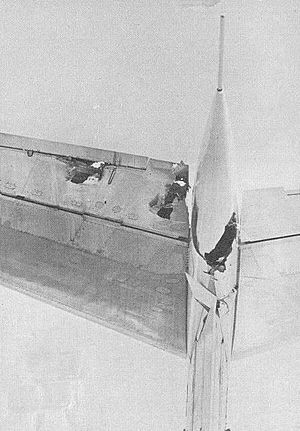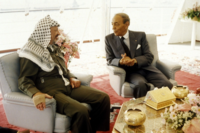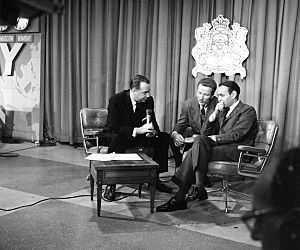Hassan II of Morocco facts for kids
Quick facts for kids Hassan IIالحسن الثاني |
|||||
|---|---|---|---|---|---|
| Amir al-Mu'minin | |||||
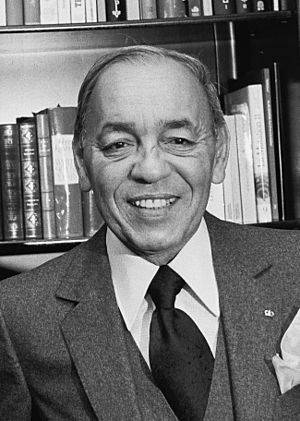
Hassan II in 1983
|
|||||
| King of Morocco | |||||
| Reign | 26 February 1961 – 23 July 1999 | ||||
| Predecessor | Mohammed V | ||||
| Successor | Mohammed VI | ||||
| Prime Ministers |
See list
Ahmed Bahnini
Mohamed Benhima Ahmed Laraki Mohammed Karim Lamrani Ahmed Osman Maati Bouabid Azzeddine Laraki Abdellatif Filali Abderrahmane Youssoufi |
||||
| Born | 9 July 1929 Dar al-Makhzen, Rabat, Morocco |
||||
| Died | 23 July 1999 (aged 70) Rabat, Morocco |
||||
| Burial | Royal Mausoleum, Rabat, Morocco | ||||
| Spouse | Princess Lalla Latifa | ||||
| Issue |
|
||||
|
|||||
| Arabic | الحسن الثاني | ||||
| Dynasty | 'Alawi | ||||
| Father | Mohammed V | ||||
| Mother | Lalla Abla bint Tahar | ||||
| Religion | Sunni Islam | ||||
| Education |
|
||||
| Military career | |||||
| Allegiance | Morocco France |
||||
| Service/ |
Royal Moroccan Armed Forces French Navy |
||||
| Rank | Field Marshal | ||||
| Battles/wars |
|
||||
Hassan II (born 9 July 1929 – died 23 July 1999) was the King of Morocco from 1961 until his death. He was a member of the 'Alawi dynasty, a royal family that has ruled Morocco for centuries.
Hassan II was the oldest son of Sultan Mohammed V and his second wife, Lalla Abla bint Tahar. He was the first leader of the Royal Moroccan Armed Forces and became crown prince in 1957. He became king in 1961 after his father passed away. His time as king included the start of the Western Sahara conflict and the Sand War. He also survived two attempts to remove him from power in 1971 and 1972. After his death, a special group was formed to look into past events during his rule.
Contents
Early life and education
Hassan was born on 9 July 1929, in Rabat, Morocco. His father was Sultan Mohammed V. He first studied Islamic sciences in Fez. Later, he attended the Royal College in Rabat. Here, he learned in both Arabic and French.
In 1943, when he was 12, Hassan attended the Casablanca Conference. He met important leaders like U.S. President Franklin D. Roosevelt. In 1947, he joined his father for a speech in Tangier. His father spoke about uniting Morocco, which inspired many Moroccans.
Hassan later studied public law at the University of Bordeaux in France. After his studies, he served in the French Navy.
Exile and return

In 1953, French authorities sent Hassan and his family away from Morocco. They were first sent to Corsica and then to Madagascar. This made many people in Morocco upset and fueled the fight for independence. During this time, Hassan helped his father with political advice. They returned to Morocco in November 1955.
After Morocco gained independence from France, his father made him the first Commander in Chief of the new Royal Moroccan Armed Forces in 1956. He led the army to victory in the Rif revolt that same year. In 1957, Hassan was named Crown Prince. He became prime minister in 1961.
Becoming King
On 26 February 1961, Crown Prince Hassan became the King of Morocco. This happened after his father, King Mohammed V, passed away. He was officially crowned in Rabat on 3 March 1961. His first trip as King was to a meeting in Belgrade.
Changes in Morocco
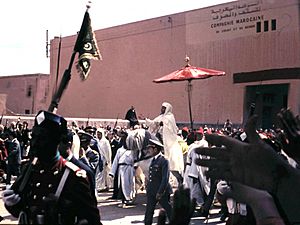
In 1962, King Hassan II helped create Morocco's first constitution. This document said Morocco would be a constitutional monarchy. It also made Islam the official religion. The constitution gave the king the title Amir al-Mu'minin, meaning "Commander of the Faithful".
In 1965, after some protests, Hassan temporarily took direct control of the country. He later brought back some parts of the parliamentary system. In the 1990s, he set up the Consultative Human Rights Council. This group looked into claims of state abuse. In 1991, he pardoned many prisoners. In 1998, the first government led by the opposition party was elected.
Surviving challenges
In the early 1970s, King Hassan survived two attempts to remove him from power. These events made his rule over Morocco stronger.
The first attempt happened on 10 July 1971, during his birthday party. About 1,000 armed rebels attacked his palace. Many people were killed. Royal troops fought back, and the attempt failed the same day.
The second attempt happened on 16 August 1972. Military jets fired at the King's plane while he was flying. The plane was badly damaged, but Hassan was able to land it safely. He then escaped to his palace. Many people involved in this attempt were arrested.
Conflicts and land gains
In 1963, the Sand War started between Morocco and Algeria. This happened because of disagreements over borders. The war caused economic problems for both countries. A peace treaty ended the war in 1969. Hassan later called the war "stupid."
In 1973, Hassan sent Moroccan troops to help Egypt and Syria during the Yom Kippur War. During his reign, Morocco also gained control of Ifni in 1969. In 1975, Morocco gained control of two-thirds of what was then Spanish Sahara through a peaceful march called the Green March.
Relations with other countries
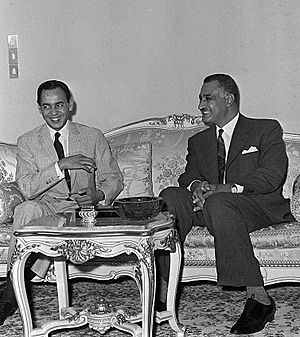
During the Cold War, Hassan II made Morocco an ally of Western countries, especially the United States. He also accepted aid from the Soviet Union. He once said, "We can wed East and West and be faithful to both."
In 1974, he created an agency called Bayt Mal Al Qods Acharif (BMAQ). This group works to protect the Arab-Muslim heritage of Jerusalem. It helps restore mosques and build schools and hospitals there.
Hassan also helped with peace talks between Arab countries and Israel. In 1977, he hosted secret meetings that led to the Egypt–Israel peace treaty.
Economy and development
Economically, Hassan II supported a market economy. This means that businesses are mostly owned by private individuals, not the government. Agriculture, tourism, and phosphate mining were very important industries. In 1967, he started a large project to irrigate over a million hectares of land.
In 1973, he announced a "Moroccanization" policy. This meant that many foreign-owned businesses were transferred to Moroccan companies. Later, in 1988, he started a policy of privatization. This meant that many government-owned companies were sold to private owners.
Later years and human rights
Hassan's rule faced criticism regarding human rights, especially during the 1960s to late 1980s. This period was sometimes called the "years of lead." During these times, many people who disagreed with the government faced difficulties. However, due to international pressure, Hassan II gradually worked to make Morocco more democratic in the 1990s. Since then, human rights in Morocco have improved.
Death and legacy
On 23 July 1999, King Hassan II passed away at the age of 70. He had been hospitalized for a lung condition. The Moroccan government declared 40 days of mourning. Many other countries also declared days of mourning.
A national funeral service was held for him in Rabat on 25 July. Over 40 world leaders attended, including U.S. President Bill Clinton and UN Secretary-General Kofi Annan. He was buried in the Mausoleum of Mohammed V. His son, Mohammed VI, became the new King of Morocco a week after his father's death.
Hassan II was known for being knowledgeable in architecture, medicine, and technology. He spoke Arabic and French fluently, and also spoke English well.
Personal life
In 1961, King Hassan II married Lalla Latifa Amahzoune. They had five children:
- Princess Lalla Meryem (born 1962)
- King Mohammed VI (born 1963)
- Princess Lalla Asma (born 1965)
- Princess Lalla Hasna (born 1967)
- Prince Moulay Rachid (born 1970)
Honors and decorations
| Royal styles of King Hassan II of Morocco |
|
|---|---|
 |
|
| Reference style | His Majesty |
| Spoken style | Your Majesty |
National orders
 Grand Master of the Order of Muhammad
Grand Master of the Order of Muhammad Grand Master of the Order of the Throne
Grand Master of the Order of the Throne Grand Master of the Order of the Independence
Grand Master of the Order of the Independence Grand Master of the Order of Ouissam Alaouite
Grand Master of the Order of Ouissam Alaouite Grand Master of the Order of Fidelity
Grand Master of the Order of Fidelity Grand Master of the Order of Military Merit
Grand Master of the Order of Military Merit Grand Master of the National Order of Merit
Grand Master of the National Order of Merit Grand Master of the National Order of Prosperity
Grand Master of the National Order of Prosperity
Foreign orders
 Grand Star of the Order of Merit of the Austrian Republic
Grand Star of the Order of Merit of the Austrian Republic Grand Collar of the Order of al-Khalifa of Bahrain
Grand Collar of the Order of al-Khalifa of Bahrain Grand Cordon of the Order of Leopold of Belgium
Grand Cordon of the Order of Leopold of Belgium Grand Cross of the Royal Order of Cambodia
Grand Cross of the Royal Order of Cambodia Knight of the Order of the Elephant of Denmark
Knight of the Order of the Elephant of Denmark Grand Cordon of the Order of the Nile of Egypt
Grand Cordon of the Order of the Nile of Egypt Grand Cross of the Legion of Honour of France
Grand Cross of the Legion of Honour of France Grand Cross Special Class of the Order of Merit of the Federal Republic of Germany
Grand Cross Special Class of the Order of Merit of the Federal Republic of Germany Grand Cross of the Order of the Redeemer of Greece
Grand Cross of the Order of the Redeemer of Greece Grand Collar of the Order of Pahlavi of Iran
Grand Collar of the Order of Pahlavi of Iran Grand Cordon of the Order of the Two Rivers of Iraq
Grand Cordon of the Order of the Two Rivers of Iraq Knight Grand Cross with Collar of Order of Merit of the Italian Republic
Knight Grand Cross with Collar of Order of Merit of the Italian Republic Collar of the Order of al-Hussein bin Ali of Jordan
Collar of the Order of al-Hussein bin Ali of Jordan Collar of the Order of Mubarak the Great of Kuwait
Collar of the Order of Mubarak the Great of Kuwait Extraordinary Grade of the Order of Merit of Lebanon
Extraordinary Grade of the Order of Merit of Lebanon Grand Cordon of the Order of Idris I of Libya
Grand Cordon of the Order of Idris I of Libya Grand Cross of the National Order of Mali of Mali
Grand Cross of the National Order of Mali of Mali Grand Cordon of the Order of National Merit of Mauritania
Grand Cordon of the Order of National Merit of Mauritania Knight Grand Cross of the Order of the Netherlands Lion
Knight Grand Cross of the Order of the Netherlands Lion Special Class of the Order of Oman
Special Class of the Order of Oman Grand Cross of the Order of Pakistan, First Class
Grand Cross of the Order of Pakistan, First Class Grand Collar of the Order of Prince Henry of Portugal
Grand Collar of the Order of Prince Henry of Portugal Grand Cross of the Order of the Tower and Sword of Portugal
Grand Cross of the Order of the Tower and Sword of Portugal Grand Cordon of the Order of the Independence of Qatar
Grand Cordon of the Order of the Independence of Qatar Order of Abdulaziz al Saud of Saudi Arabia, 1st Class
Order of Abdulaziz al Saud of Saudi Arabia, 1st Class Collar of Civil Order of Alfonso X, the Wise of Spain
Collar of Civil Order of Alfonso X, the Wise of Spain Collar of the Order of Charles III of Spain
Collar of the Order of Charles III of Spain Grand Cordon of the Order of Merit of Sudan
Grand Cordon of the Order of Merit of Sudan Wissam of the Order of Oumayid of Syria
Wissam of the Order of Oumayid of Syria Grand Cordon of the Order of the Republic of Tunisia
Grand Cordon of the Order of the Republic of Tunisia Grand Collar of the Order of the Seventh of November of Tunisia
Grand Collar of the Order of the Seventh of November of Tunisia Honorary Knight Grand Cross of the Order of the Bath of Great Britain and Northern Ireland
Honorary Knight Grand Cross of the Order of the Bath of Great Britain and Northern Ireland Honorary Knight Grand Cross of the Royal Victorian Order of Great Britain and Northern Ireland
Honorary Knight Grand Cross of the Royal Victorian Order of Great Britain and Northern Ireland Collar of the Order of Etihad (Order of the Federation)
Collar of the Order of Etihad (Order of the Federation) Yugoslav Great Star
Yugoslav Great Star
Honorary prizes
- In 2022, Hassan was given the Pan-African Prize after his death. This was for his help in creating the African Union and supporting Pan-Africanism.
See also
 In Spanish: Hasán II de Marruecos para niños
In Spanish: Hasán II de Marruecos para niños



